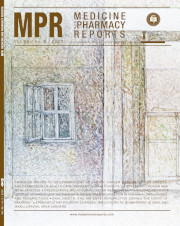Recurrent submandibular fistula after Sunitinib treatment in a patient with renal cell carcinoma: a case report
DOI:
https://doi.org/10.15386/mpr-2502Keywords:
submandibular fistula, sunitinib, osteonecrosis of the jaw, renal cell carcinomaAbstract
Sunitinib is commonly used in the treatment of patients with renal cell carcinoma and is associated with serious side-effects. We present the first report of a recurrent submandibular fistula in a patient treated with sunitinib. A 68-year-old man was referred to our clinic for a cutaneous fistula situated on the right side of his lower jaw. The patient had been diagnosed with bone metastases from a renal carcinoma 2 years ago and had received a single 4 mg dose of zoledronic acid and subsequent treatment with sunitinib 37.5 mg once daily for the past 4 weeks. The patient was treated surgically by a perilesional incision and primary closure with sutures, advised on meticulous oral hygiene and was kept on an antimicrobial agent in the form of clindamycin. After reinitiating his oncological treatment with sunitinib the cutaneous fistula re-appeared and bone abnormalities were also detected on his X-ray. After 18 months a contralateral cutaneous fistula was observed along with a spontaneous avulsion of the patient’s left molar. Repeat surgical treatment and sequestrectomy was performed with the subsequent histopathological examination revealing a suspicion of osteonecrosis of the jaw and an associated Actinomyces infection.
Downloads
Published
How to Cite
Issue
Section
License
The authors are required to transfer the copyright of the published paper to the journal. This is done by agreeing to sign the Copyright Assignment Form. Whenever the case, authors are also required to send permissions to reproduce material (such as illustrations) from the copyright holder.

The papers published in the journal are licensed under a Creative Commons Attribution-NonCommercial-NoDerivatives 4.0 International License.

